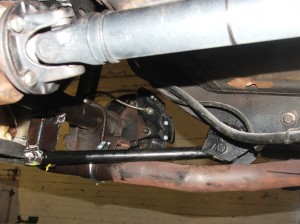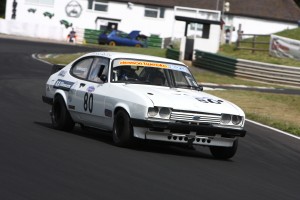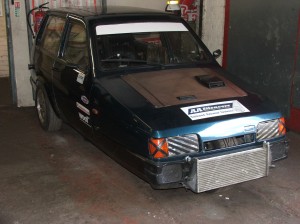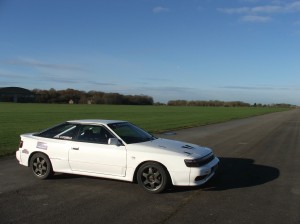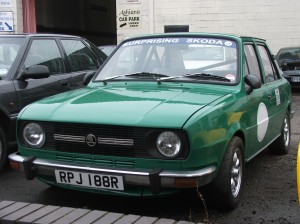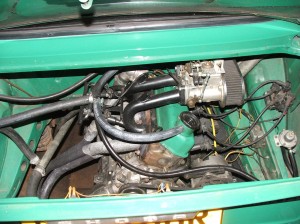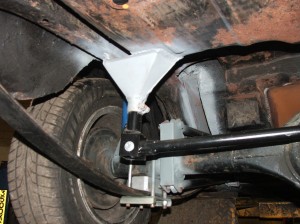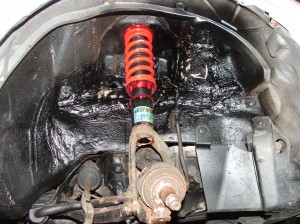The AA Sport/AA Silencers Capri race car continues to be developed in between other commitments. The latest development is with the rear axle location. These bars reduce both axle tramp and lateral movement. An added advantage is that by moving the pickup points we’ve been able to change the roll axis of the car and hopefully improve the handling. More testing is required but it looks good so far
Posts Tagged ‘suspension’
Capri Development
Tuesday, August 14th, 2012It’s what we do- excerpt from an article for Practical Performance Car magazine
Friday, April 27th, 2012It’s strange that the first question people ask when they’re checking out modified cars is often ‘How much power has it got?’ It’s all well and good being able to say it’s got 400 bhp, but how much weight is that power having to shift? If the car weighs two tonnes then you’ve only got 200 bhp per tonne, which is suddenly less impressive. That’s only equal to a 100 bhp engine in a 500 kg car. The thing is if you tell people you’ve only got 100 bhp they’ll snigger and walk away. ‘Pfff, my Mom’s Corsa has got more power than that’. The conversation’s over before anyone mentions weight.
Weight goes far beyond the simple bhp/tonne figure though. Bigger engines will often produce more than enough power to compensate for their extra weight. Carrying a hoofing great engine around does nothing for the handling though. The overall weight of a car will make a huge difference to how it accelerates, brakes and turns into a corner. The distribution of the weight in the car is just as important and can be used to either tune or ruin the handling characteristics.
It’s fairly obvious that having a light car means you can accelerate and brake faster, there’s less weight to move around. But just as important is how the weight is spread out across the cars tyres. Each tyre is actually holding up a different weight. In most road cars with the engine up front, the front tyres are holding up a lot more weight than the rears. Likewise with only the driver in, the off side tyres are carrying more weight than the nearside. Amongst other things, the amount of weight (or down force) a tyre has on it will dictate how much grip it can produce, up to a point. From that you could think a heavier car could corner faster. The problem is that the cars weight also acts sideways in a corner and it takes some of the available grip of the tyre and pulls it sideways, causing the tyre to ‘scrub‘. All tyres scrub sideways when turning, it’s known as the slip angle. Push the slip angle too far and you’re sliding, push the slide too far and you’re spinning. Heavier cars increase slip angles faster than light ones so they run out of grip faster.
To help ensure each tyre is carrying an equal load to start with, cars can be corner weighted. That involves raising the spring heights so more load goes onto the corners where there was less. Unless you have a very well balanced car the weight distribution will always be biased in one direction or another, but it helps to spread the cars weight as evenly as possible. This means each tyre is doing it’s fair share of clinging your car to the road. Corner weighting a car doesn’t necessarily move the weight distribution in the car, it just alters how the car’s suspension supports it.
Of course all that talk of spreading the weight out on the tyres is massively over simplified. There’s so many other factors influencing how the car’s suspension behaves, and all we’ve considered so far is how the weight is supported across the four corners. We should also spare a thought for where the weight is in the car. Rather than just say the car has weight, the weight distribution around the car can all be added up and said to have a centre of gravity. It’s basically the balance point for all the weight in the car. If the car was hung from a rope attached at the centre of gravity it would always be balanced. The centre of gravity also has a height within the car. The higher the centre of gravity the more a car will lean as it corners. It leans, or rolls because opposing forces act on the centre of gravity as you corner. It’s those forces you can feel when you are pushed out of your seat as the car brakes or corners. This is called weight transfer. The more it rolls during a corner the more it takes load off the inside tyres reducing the overall grip available to the car.
The centre of gravity rolls around a pivot point called its roll centre, which is set by the cars suspension pick up points. Unless you’re planning on moving the suspension pick up points the best way to reduce the amount of roll a car has is make it lighter and get the weight as low down in the car as possible. Stiffer suspension springs will resist body roll. Generally you’ll always want the softest springs possible for traction but stiff enough to stop too much weight transfer. Assuming your tyres are up to the job of transmitting the load then sometimes a bit more weight transfer in a straight line (pitch) helps push them into the road surface and get more grip. For example if you have a rear wheel drive car with the engine at the front you’ll need a bit of weight transfer to get the driving tyres to grip properly. Generally though too much weight transfer reduces grip and ruins the balance in the car, especially during cornering (roll). It’s that balance that everyone’s trying to find when they set a car up. How much weight your car has and where it’s distributed will affect how much weight transfer you have, how much work your suspension is having to do and so how hard you can push your tyres when accelerating, braking and cornering. Performance driving techniques are all developed around shifting the balance around the tyres to get the best grip for the longest time. It’s all of these factors and more that we focus on when developing a car, and it’s driver.
The Pig flies again
Friday, April 27th, 2012Our very own Reliant Robin, or the Flying Pig as it’s become known, took to the strip at Santa Pod recently. This was just a test run for the newly turbo charged engine. We fitted the turbo to blow through the standard carb with a few modifications. The test ran well although it was on very low boost so the car is now ready for Practical Performance Car magazines show at Mallory Park. The Robin draws a crowd wherever it goes and is a challenge to drive. We wanted to build a car to prove we can make anything handle. With a modified double wishbone front suspension set up it corners and brakes as it should now. It just goes to prove anything is possible. Check it out on our you tube channel at http://www.youtube.com/watch?v=n3exKXBlqFY
Boys Toys
Tuesday, November 29th, 2011This BMW is a track day regular but as the owners talent has grown he felt the need for more grip. We carried out a full geoetry check but as a lot of the car was standard we could do little more than adjust the tracking. The customer decided to start his upgrades with a set of camber adjustable top mounts. These allowed us to improve the geometry to give him more front end grip. Next on the list is a set of coilovers. One step at a time though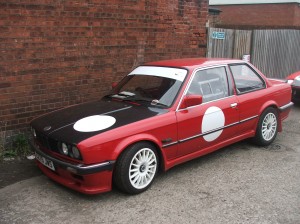
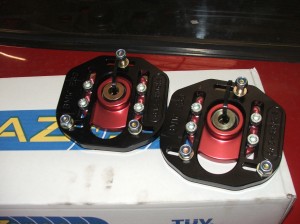
Classic Celica
Monday, November 29th, 2010Another car for a feature in Practical Performance car. This time we joined the owner on a track day to gather some data on how his car handled. With some 380 BHP on tap the suspension was having to work pretty hard. Improvements were made on the day and using the data we’ve gathered there’s plenty more still to come. It’s lovely to see a real classic rally car like this still being used in anger on sprints and hill climbs
Snotty Skoda
Monday, November 29th, 2010I’m not being rude, Snotty is the nick name that’s been given to the Skoda, probably for obvious reasons. The cars owner has done a wonderful job of preparing the car for sprints and hill climbs. It has come to us for a Car Clinic feature in Practical Performance Car magazine. We carried out a full geomtry set up and made a few light modifications to the front suspension to help with grip. The car was tested at Mallory park and the owner now has all winter to carry out the suggested developments. If you come across this Skoda out on the road you’d better give him room, it’s a whole lot more car than it first appears. Or than the name suggests!
What linkeage?
Monday, November 29th, 2010Another old escort made it’s way in for a Watt’s linkeage, some seat mounts and a few other bits and pieces. The watts linkeage is designed to control lateral loads on the axle and stop it moving about when cornering. We just had to weld the mounts in to the body and axle ensuring everyting was lined up correctly. The car already had 4 link boxes and slipper springs fitted so it won’t be long until this one’s back on the road.
track day civic
Monday, September 13th, 2010This civic came in needing an MoT and setting up for the race track. The two things don’t normally go hand in hand but this little terrier has to do daily driving duties and will see some serious track day action too. There a was a big list of work including welding and various suspension upgrades, wheel bearings, brakes etc. Once it was all assembled the geometry equipment came out to make sure everything was pointing in the right direction and away it went for it’s MoT. With a green ticket first time through the owner went away with a big smile and no doubt headed for the nearest race track.
When no-one else can help….
Thursday, June 10th, 2010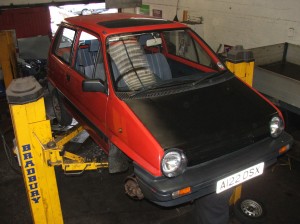
Ever seen a honda Jazz before? Not many people have because there’s not many around. Even rarer than Honda Jazz are parts for a Honda Jazz.
Most of these old jap cars have rotten away long before they reach the Retro Cool status that this little town car has achieved. It came to us for a little exhaust work and some of the inevitable welding that goes into owning an old car. To be fair it was in very good condition, just a patch or two here and there followed by a liberal dose of waxoyl. The main problem was the bottom ball joints in the front suspension. They are as rare as the preverbial teeth from a hen and when we did find some they cost more than the car did. The solution was to break out the parts catalogue and get welding.
We found that some Peugeot ball joints had the same dimensions so the lower arms were measured and moddified to take some bolt on ball joints. It takes a whole lot longer to do than it does to say but we’ve done this several times on track cars to get more camber on them and the results speak for themselves.
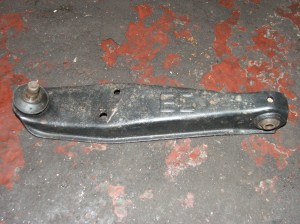
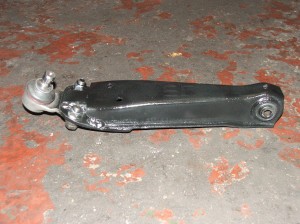
TVR suspension that fights back
Tuesday, December 1st, 2009I must confess to having a big soft spot for TVR’s of all ages even though I am more than aware of their various reputations for reliability. As such I was looking forward to having this one in for a set of replacement coilovers and a quick set up of the geometry. All went according to plan and the car was set up for a comfortable neutral ride a requested. We took the car out for a test drive and the ride was perfect. On the return journey though the car faltered at a set of traffic light and the engine died. The TVR reliability reputaion had caught up with us.
The car was recovered back to the garage and work began on rectifying the problem. every now and again the car would spring to life and run for a short distance only to die and require recovering again. After much swearing, buning of hands on the cars beautifully promenant but extremely hot exhaust and a few cups of tea later the problem was traced to a loose fuel pump connection. The terminal was recrimped and away went our customer to enjoy his comfy suspension.


